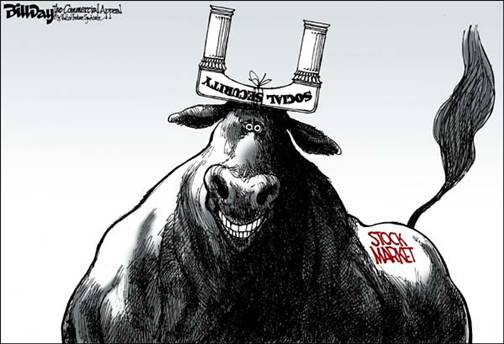|
|
Social Security A 'New Business Opportunity'
Managers Stand To Gain Millions in Private Accounts
By Tami Luhby, Newsday
February 21, 2005

Bill Day
No one knows whether workers would prosper in private Social Security accounts, but financial firms would likely pull in big bucks.
From mutual fund managers to brokerage firms to investment advisers, financial-services companies could in time earn hundreds of millions of dollars a year in fees and other revenue if workers were allowed to invest part of their payroll taxes in the stock market, as President Bush is proposing.
"Financial firms would be crazy not to look at this as a new business opportunity," said Robert Hegarty, vice president of securities and investment at TowerGroup, a financial research firm in Needham, Mass. "It's a huge potential revenue stream over the long term."
Some, however, don't expect a windfall from privatization. The securities industry chief lobbying group says fees from the private accounts would total only a fraction of Wall Street's overall revenues.
Money management firms are laying low in the heated debate over privatization. Many are saying publicly that they haven't taken a position on Bush's plan and privately that they have no interest in managing tens of millions of tiny accounts.
The Securities Industry Association calculated that the plan would generate at most $279 billion in fees, or about 8.6 percent of the $3.3 trillion in the financial sector's total revenues, over 75 years.
"This wouldn't be a bonanza for Wall Street," said Rob Mills, Securities Industry Association director of industry research. "The fees charged on these accounts would be less than those charged on full-service mutual fund accounts."
Just who benefits and by how much depends on a number of factors. Among the most important is whether workers eventually would be able to invest in a wider range of actively managed mutual funds, which command much higher fees.
The president has yet to provide details on his Social Security reform plan. At this point, he's said that workers would be allowed to divert up to 4 percentage points of their payroll taxes, with a $1,000 annual maximum, to private accounts.
The money could be invested in a handful of index funds, which simply mimic an index such as the Standard & Poor's 500 and thus typically have low management fees, and a life-cycle fund, which shifts its asset allocation from stocks to bonds depending on the investor's age, according to the president's proposal.
The White House said last week that it is not addressing at this time the issue of expanding investment choices once workers accumulate a certain balance, as has been suggested in other reform plans.
If investors could choose from a large number of actively managed funds, financial firms could earn as much as $940 billion in investment manage-
ment fees over 75 years, said Austan Goolsbee, an economics professor at the University of Chicago Graduate School of Business.
In these funds, a manager must select the stocks and bonds, enabling the fund to charge higher fees.
These higher fees could eat away at the balances workers would receive at retirement.
"The real money to be made is if they turn it over to the private sector and allow it to be actively managed," Goolsbee said.
|
|



